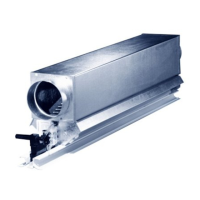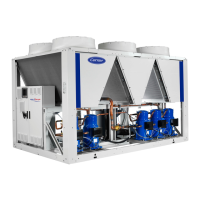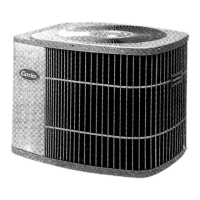37MARAQ: Installation Instructions
Manufacturer reserves the right to change, at any time, specifications and designs without notice and without obligations.
26
D. AIR EVACUATION
EVACUATION COIL AND TUBING SYSTEM
Refrigerant tubes and the indoor coil should be evacuated using the
recommended 500 microns deep vacuum method. The alternate triple
evacuation method may be used if the procedure outlined below is followed.
NOTE: Always break a vacuum with dry nitrogen.
NOTE: The service port (Schrader Fitting) for R454b refrigerant is a
special fitting that requires a new type adapter. The Service
Port Adapter used for R410A refrigerant units will not
work with the new equipment. This new adapter uses
Reverse threads (Left-Hand Thread) and must be obtained
from distributor or supply house.
Fig. 23 — Service Valve
Fig. 24 — Manifold
Evacuation
Evacuation of the system removes air or nitrogen (non-condensables) as well
as moisture. A proper vacuum assures a tight, dry system before charging
with refrigerant. The two methods used to evacuate a system are the Deep
Vacuum Method and the Triple Evacuation Method.
Deep Vacuum Method
The deep vacuum method requires a vacuum pump capable of pulling a vacuum
of 500 microns and a vacuum gauge capable of accurately measuring this
vacuum depth. The deep vacuum method is the most positive way of assuring a
system is free of air and moisture (see Figure 25).
Fig. 25 — Deep Vacuum Graph
Triple Evacuation Method
The triple evacuation method should be used when the vacuum pump is
not capable of pumping down to 500 microns and system does not contain
any liquid water. Refer to Fig. 26 and proceed as follows:
1. Attach refrigeration gauges and evacuate system down to 28 in. of
mercury and allow pump to continue operating for an additional 15
minutes.
2. Close service valves and shut off vacuum pump.
3. Connect a nitrogen cylinder and regulator to system and flow nitrogen
until system pressure is 2 psig.
4. Close service valve and allow system to stand for 1 hour. During this
time, dry nitrogen will be able to diffuse throughout the system
absorbing moisture.
5. Repeat this procedure as indicated in Fig. 26. System will then be free
of any contaminants and water vapor.
Fig. 26 — Triple Evacuation Method
Final Tubing Check
IMPORTANT:
Check to be certain factory tubing on both the indoor
and outdoor unit has not shifted during shipment. Ensure tubes are not
rubbing against each other or any sheet metal. Pay close attention to the
feeder tubes, making sure wire ties on feeder tubes are secure and tight.
UNIT DAMAGE HAZARD
Failure to follow this caution may result in equipment damage or improper
operation. Never use the system compressor as a vacuum pump.
CAUTION
Outdoor Unit Indoor UnitRefrigerant
Service Valve
Low Side
High Side
A
B
C
D
500 microns
Low side valve
High side valve
Charge hose
Charge hose
Vacuum pump
Low side valve
500
MINUTES
01234567
1000
1500
LEAK IN SYSTEM
SYSTEM TIGHT
EVACUATE MOISTURE
TIGHT DRY SYSTEM
2000
MICRONS
2500
3000
3500
4000
4500
5000
WAIT
EVACUAT E
WAIT
BREAK VACUUM WITH DRY NITROGEN
EVACUATE
EVACUATE
BREAK VACUUM WITH DRY NITROGEN
CHECK FOR TIGHT, DRY SYSTEM
(IF IT HOLDS DEEP VACUUM)
RELEASE CHARGE INTO SYSTEM
Refrigerant charging must be performed after wiring, vacuuming, and
the leak testing.
DO NOT
exceed the maximum allowable quantity of refrigerant or
overcharge the system. Doing so can damage the unit or impact it’s
functioning. Charging with unsuitable substances may cause explosions or
accidents. Ensure that the appropriate refrigerant is used.
Refrigerant containers must be opened slowly. Always use protective
gear when charging the system.
DO NOT mix refrigerants types.
CAUTION

